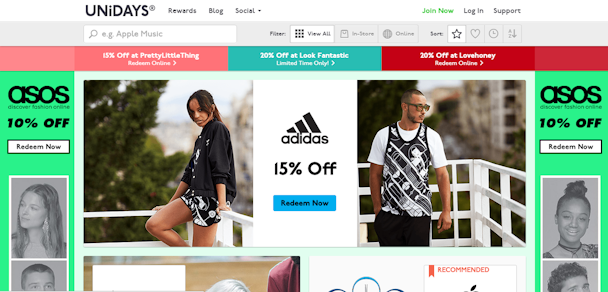Unidays sets up dedicated division to help retailers understand student shopping behaviour
Student discounting site Unidays is looking to help retailers better understand how to engage with younger demographics both online and in-store, setting up a dedicated division which will be led by recently appointed head of retail innovation Carl Aelle.

Unidays
At its heart, Unidays verifies student identities before serving a raft of discounts and student perks, many of them exclusive to the site, that are offered by retail partners. But it’s now entering territory usually reserved for agencies, believing its deep knowledge of students - where and how they shop and ultimately what they buy - will give it the edge in helping brands optimise the shopping experience for the hard to reach demographic.
“As brands are figuring out their omnichannel strategies there’s a hell of a lot of different processes to think about and a lot of energy is put into those complexities and the technology etc. Sometimes [they] don’t get passed that before looking at the segment of customers and what they actually want or most engaged in,” Aelle recently told The Drum.
“Unidays, having so much information on students, can help and we’re finding brands are really keen to obtain that information and understand [students] better.”
The business currently has eight million students across the UK, US, Australia and New Zealand registered on its platform, which drive 10.5 million impressions on its website each month and delivers in excess of five million emails a month.
But, the key stat it will be parading to retailers is the claim that it has directly generated over $1bn in revenue for its 500 brand partners – which include Asos, Apple, Topshop and Adidas – in the last 12 months.
“We’re anticipating that will grow to $2bn this year,” said Aelle. “And we’ll double [the number of brands on our platform] by December.”
As it looks to bring more value to those brand relationships, Unidays is building a number of retail focused teams internally.
One division will be charged with looking five years into the future at what technologies students will use to shop.
Another will liaise with brands now, trying to help them see through the lens of a student and optimise the channels they’re using and the tech they should be deploying to improve the experience in the short term.
“One of the big things is all the old legacy systems that very often don’t speak to each other and don’t connect well to our infrastructure,” he said.
“But there are ways to connect that whole customer journey across the touchpoints and we can then track some of the things retailers have really been craving over the years.”
The app has been downloaded over two million times to date and during term time and other key calendar moments, such as loans landing in bank accounts, it sees strong uplift in usage. This makes harnessing tech tools such as beacons and geo-location much easier and it can help retailers with an offline presence to understand things like customer flow, dwell time in-store and footfall as well as linking that to online activity prior to coming in.
Another area it’s keenly interested in educating brands is around emerging social channels.
“Brands are desperately trying to comprehend Snapchat but there’s [other] apps– like YikYak, a new geo-targeted app allowing you to speak to people within the radius of a campus – that are being used by students.
“And that’s a big challenge; some brands haven’t even heard of the social channels [like YikYak] that students find interesting let alone thought up how they’ll set up and manage them. But it’s really important for that audience and we’re trying to help brands understand those things,” explained Aelle.
While Aelle has only been in the role six weeks, his ambition for Unidays to be seen as not just a place to promote a discount code but a source of insight and experience on student shopping behaviour. And with those aged 18 to 24 years-old are the most prevalent users of ad blockers, advertisers could use all the help they can get.

